Cavitation Damage Prediction in Mercury Target for Pulsed Spallation Neutron Source Using Monte Carlo Simulation
Abstract
:1. Introduction
2. Experiments
3. Numerical Analysis
3.1. Flow of Analysis
3.2. Modeling Scatter of Cavitation Damage
3.3. Monte Carlo Simulation
- (i)
- The probability density function of the maximum impact pressure was selected from Equations (6)–(8).
- (ii)
- The density of the bubble core Mbubble was inputted to the model. It was assumed that 0.1 bubbles per cycle affect the simulation area measuring 200 μm × 200 μm. This frequency was calculated from the measured bubble density [24].
- (iii)
- The number of impact cycles Ncycle was inputted to the model from 200 to 104.
- (iv)
- The random number between 0 and 1 was generated, and then (iv) was repeated while increasing the number of the iteration j by 1 until K was less than Mbubble.
- (v)
- The bubble position was selected using a uniform random number in the area measuring 200 μm × 200 μm, and then (iv) and (v) were repeated while increasing the number of the iteration j by 1 until j was larger than Ncycle.
3.4. Inverse Analysis
4. Results
4.1. Inverse Analysis on Expected Value Pmax,0 and Dispersion r
4.2. Comparison with Experimental Results
5. Discussions
5.1. Local Deformation of Pit
5.2. Physical Meanings of Probability Distribution Functions
6. Conclusions
- (1)
- Regardless of the probability density function type of the maximum localized impact pressure, the expected reference value of the maximum impact pressure and the dispersion of the Gaussian distribution of the maximum impact pressure were 1.2–2.9 GPa and 1.0–1.7 μm, respectively. These values were within the range of the experimental results.
- (2)
- Although no significant differences in the fraction obtained by using probability density functions were found, the two-dimensional distribution of pits and the histogram of the pit diameter obtained by the Weibull distribution sufficiently reproduced the experimental results.
- (3)
- The depth profile of pits estimated by using the Weibull distribution reproduced the experimental results better than that using the delta function and the Gaussian distribution.
- (4)
- As results of (2) and (3), it can be said that the cavitation erosion phenomenon is predictable by adopting the Weibull distribution.
Author Contributions
Funding
Data Availability Statement
Acknowledgments
Conflicts of Interest
References
- Harjo, S.; Gong, W.; Aizawa, K.; Kawasaki, T.; Yamasaki, M.; Mayama, T.; Kawamura, Y. Effect of Extrusion Ratio in Hot-Extrusion on Kink Deformation during Compressive Deformation in an αMg/LPSO Dual-Phase Magnesium Alloy Monitored by In Situ Neutron Diffraction. Mater. Trans. 2023, 64, 766–773. [Google Scholar] [CrossRef]
- Murakawa, T.; Kurihara, K.; Adachi, M.; Kusaka, K.; Tanizawa, K.; Okajima, T. Re-evaluation of protein neutron crystallography with and without X-ray/neutron joint refinement. IUCrJ 2022, 9, 342–348. [Google Scholar] [CrossRef] [PubMed]
- Huger, E.; Stahn, J.; Heigjans, P.; Schmidt, H. Neutron reflectometry to measure in situ the rate determining step of lithium ion transport through thin silicon layers and interfaces. Phys. Chem. Chem. Phys. 2019, 21, 16444–16450. [Google Scholar] [CrossRef] [PubMed]
- Mlf Annual Report 2021. Available online: https://mlfinfo.jp/_src/resource/PKrrqrH8Ai/MLF_AR2021.pdf (accessed on 1 June 2023).
- Futakawa, M. Targetry overview—Various target concept and expectable next generation targets in power frontier applications. JPS Conf. Proc. 2015, 8, 001002. [Google Scholar]
- Murakami, H.; Asano, H. Visualization of mass transfer phenomena in energy equipment by using neutron radiography (Application to polymer electrolyte fuel cell and refrigerating equipment). J. JSNDI 2016, 65, 25–32. [Google Scholar]
- Takada, H. Current status of the high intensity pulsed spallation neutron source at J-PARC. Plasma Fusion Res. 2018, 13, 2505013. [Google Scholar] [CrossRef]
- Kang, Y.; Aleksandrov, A.; Anderson, D.; Champion, M.; Crofford, M.; Galambos, J.; Han, B.; Kim, S.-H.; Lee, S.-W.; Longcoy, L.; et al. Status and performance of ORNL spallation neutron source accelerator system. In Proceedings of the IPAC2016, Busan, Republic of Korea, 10 May 2016. [Google Scholar]
- Chen, X.; Xu, R.Q.; Shen, Z.H.; Lu, J.; Ni, X.W. Optical investigation of cavitation erosion by laser-induced bubble collapse. Opt. Laser Technol. 2004, 36, 197–203. [Google Scholar] [CrossRef]
- Petkovsek, R.; Gregorcic, P. A laser probe measurement of cavitation bubble dynamics improved by shock wave detection and compared to shadow photography. J. Appl. Phys. 2007, 102, 044909. [Google Scholar] [CrossRef]
- Grant, M.M.; Lush, P.A. Liquid impact on a bilinear elastic-plastic solid and its role in cavitation erosion. J. Fluid Mech. 1987, 176, 237–252. [Google Scholar] [CrossRef]
- Wood, G.M.; Knudsen, L.K.; Hammit, E. Cavitation damage studies with rotation disk in the water. J. Basic Eng. 1967, 89, 98–109. [Google Scholar] [CrossRef]
- Futakawa, M.; Kikuchi, K.; Conrad, H.; Stechemesser, H. Pressure and stress waves in a spallation neutron source mercury target generated by high-power proton pulses. Nucl. Instr. Meth. Phis. Res. A 2000, 439, 1–7. [Google Scholar] [CrossRef]
- Haosheng, C.; Jiang, L.; Darong, C.; Jiadao, W. Damages on steel surface at the incubation stage of the vibration cavitation erosion in water. Wear 2008, 265, 692–698. [Google Scholar] [CrossRef]
- Chen, J.S.; Wang, J.D.; Li, Y.J.; Chen, D.R. Effect of hydrodynamic pressures near solid surfaces in the incubation stage of cavitation erosion. Proc. Inst. Mech. Eng. Part J J. Eng. Tribol. 2008, 222, 523–531. [Google Scholar] [CrossRef]
- Tzanakis, I.; Eskin, D.G.; Georgoulas, A.; Fytanidis, D.K. Incubation pit analysis and calculation of the hydrodynamic impact pressure from the implosion of an acoustic cavitation bubble. Ultrason. Sonochem. 2014, 21, 866–878. [Google Scholar] [CrossRef]
- Jones, I.R.; Edwards, D.H. An experimental study of forces generated by the collapse of transient cavities in water. J. Fluid Mech. 1960, 7, 596–609. [Google Scholar] [CrossRef]
- Futakawa, M.; Naoe, T.; Kogawa, H.; Date, H.; Ikeda, Y. Micro-impacted damage caused by mercury bubble collapse. JSME Int. J. A 2005, 48, 234–239. [Google Scholar] [CrossRef]
- Carnelli, D.; Karimi, A.; Franc, J.P. Evaluation of the hydrodynamic pressure of cavitation impacts from stress-strain analysis and geometry of individual pits. Wear 2012, 289, 104–111. [Google Scholar] [CrossRef]
- Fivel, M.; Franc, J.P.; Roy, S.C. Towards numerical prediction of cavitation erosion. Interface Focus 2015, 5, 20150013. [Google Scholar] [CrossRef]
- Aidoo, E.O. Material Response on the Cavitation Bubble Collapse. Master’s Thesis, Technical University of Liberec, Liberec, Czechia, 2018. [Google Scholar]
- Futakawa, M.; Naoe, T.; Tsai, T.T.; Kogawa, H.; Ishikura, S.; Ikeda, Y.; Date, H. Pitting damage by pressure wave in a mercury target. J. Nucl. Mater. 2005, 343, 70–80. [Google Scholar] [CrossRef]
- Futakawa, M. Proton bombardment in mercury target for neutron production—Impact dynamics on interface between liquid and solid metals. Appl. Mech. Mater. 2014, 566, 26–33. [Google Scholar] [CrossRef]
- Futakawa, M.; Naoe, T.; Kawai, M.; Tanaka, N. Visualization of mercury cavitation bubble collapse. In Proceedings of the Experimental Analysis of Nano and Engineering Materials and Structures, Alexandroupolis, Greece, 1–6 July 2007; pp. 301–302. [Google Scholar]
- Haines, J.R.; Riemer, B.W.; Felde, D.K.; Hunn, J.D.; Pawel, S.J.; Tsai, C.C. Summary of cavitation erosion investigations for the SNS mercury target. J. Nucl. Mater. 2005, 343, 58–69. [Google Scholar] [CrossRef]
- Riemer, B.W.; Haines, J.R.; Hunn, J.D.; Lousteau, D.C.; MacManamy, T.J.; Tsai, C.C. SNS target tests at LANSCE-WNR in 2001—Part I. J. Nucl. Mater. 2003, 318, 92–101. [Google Scholar] [CrossRef]
- Hunn, J.D.; Riemer, B.W.; Tsai, C.C. SNS target tests at LANSCE-WNR in 2001—Part II. J. Nucl. Mater. 2003, 318, 102–108. [Google Scholar] [CrossRef]
- Naoe, T.; Teshigawara, M.; Wakui, T.; Kinoshita, H.; Koagawa, H.; Haga, K.; Futakawa, M. Damage inspection of the first mercury target vessel of JSNS. J. Nucl. Mater. 2014, 450, 123–129. [Google Scholar] [CrossRef]
- Koagawa, H.; Naoe, T.; Futakawa, M.; Haga, K.; Wakui, T.; Harada, M.; Takada, H. Mitigation technologies for damage induced by pressure waves in high-power mercury spallation neutron sources (IV)—Measurement of pressure wave response and microbubble effect on mitigation in mercury target at J-PARC–. J. Nucl. Sci. Technol. 2017, 54, 733–741. [Google Scholar] [CrossRef]
- McClintock, D.A.; Riemer, B.W.; Ferguson, P.D.; Carroll, A.J.; Dayton, M.J. Initial observations of cavitation-induced erosion of liquid metal spallation target vessels at the Spallation Neutron Source. J. Nucl. Mater. 2012, 431, 147–159. [Google Scholar] [CrossRef]
- Riemer, B.W.; Wendel, M.W.; Felde, D.K.; Abdou, A.A.; McClintock, D.A. Status of R&D on mitigating the effects of pressure waves for the Spallation Neutron Source mercury target. J. Nucl. Mater. 2012, 431, 160–171. [Google Scholar]
- Winder, D.; McClintock, D.A.; Bruce, D. Cavitation-induced erosion in liquid metal spallation targets—A comparison between a predictive method and measured erosion damage to stainless steel target modules at the Spallation Neutron Source. Wear 2020, 450–451, 203257. [Google Scholar] [CrossRef]
- Wakui, T.; Takagishi, Y.; Futakawa, M.; Tanabe, M. Cavitation damage prediction in mercury target for pulsed spallation neutron sources by Monte Carlo simulation. J. JSEM 2023, 23, 70–76. [Google Scholar]
- Keyence Corpolation. VK Analyzer Pulse Reference Manual; Keyence Corpolation: Osaka, Japan, 2009. [Google Scholar]
- Xu, J.; Fu, L.; Mutoh, Y. Elastic-plastic boundary element analysis of interface edge in bonded dissimilar materials. J. Soc. Mat. Sci. JPN. 2000, 49, 857–861. [Google Scholar] [CrossRef]
- Miyagawa, S.; Baba, K.; Nakao, S.; Ikeyama, M.; Saitoh, K.; Miyagawa, Y. Effects of ion beam mixing on the depth profiles of thin metal layer in TiO2. Nucl. Instrum. Methods Phys. Res. B 1998, 141, 467–471. [Google Scholar] [CrossRef]
- Ghasemi, M.; Kakuee, O.R.; Fathollahi, V.; Shahvar, A.; Mohati, M.; Ghafoori, M. Physical dose distribution due to multi-sliced kV X-ray beam in labeled tissue-like media: An experimental approach. App. Radiat. Isot. 2011, 69, 482–491. [Google Scholar] [CrossRef]
- Nyabadza, A.; Vazquez, M.; Brabazon, D. Modeling of pulsed laser ablation in liquid via Monte Carlo techniques: The effect of laser parameters and liquid medium on the electron cloud. Solid State Sci. 2022, 133, 107003. [Google Scholar] [CrossRef]
- Wu, X.; Kozlowski, T.; Meidani, H.; Shirvan, K. Inverse uncertainty quantification using the modular Bayesian approach based on Gaussian process, Part 1: Theory. Nucl. Eng. Des. 2018, 335, 339–355. [Google Scholar] [CrossRef]
- Matsui, K.; Knamori, K.; Toyoura, K.; Takeuchi, I. Introduction to Bayesian optimization and its application to material engineering. Materia 2019, 1, 12–16. [Google Scholar] [CrossRef]
- Radaideh, M.I.; Lin, L.; Jiang, H.; Cousineau, S. Bayesian inverse uncertainty quantification of the physical model parameters for the spallation neutron source first target station. Results Phys. 2022, 36, 105414. [Google Scholar] [CrossRef]
- MathWorks. Available online: https://jp.mathworks.com/help/stats/ (accessed on 1 June 2023).
- COMSOL. Available online: https://www.comsol.jp/documentation (accessed on 1 June 2023).
- Sakai, T.; Tokai, K.; Hasegawa, N.; Nakajima, M. Statistical distribution patterns of static and fatigue properties for metallic materials. J. Soc. Mat. Sci. 1992, 41, 1014–1024. [Google Scholar] [CrossRef]
- Gaenser, H.P. Some notes on gradient, volumetric and weakest link concepts in fatigue. Comput. Mater. Sci. 2008, 44, 230–239. [Google Scholar] [CrossRef]




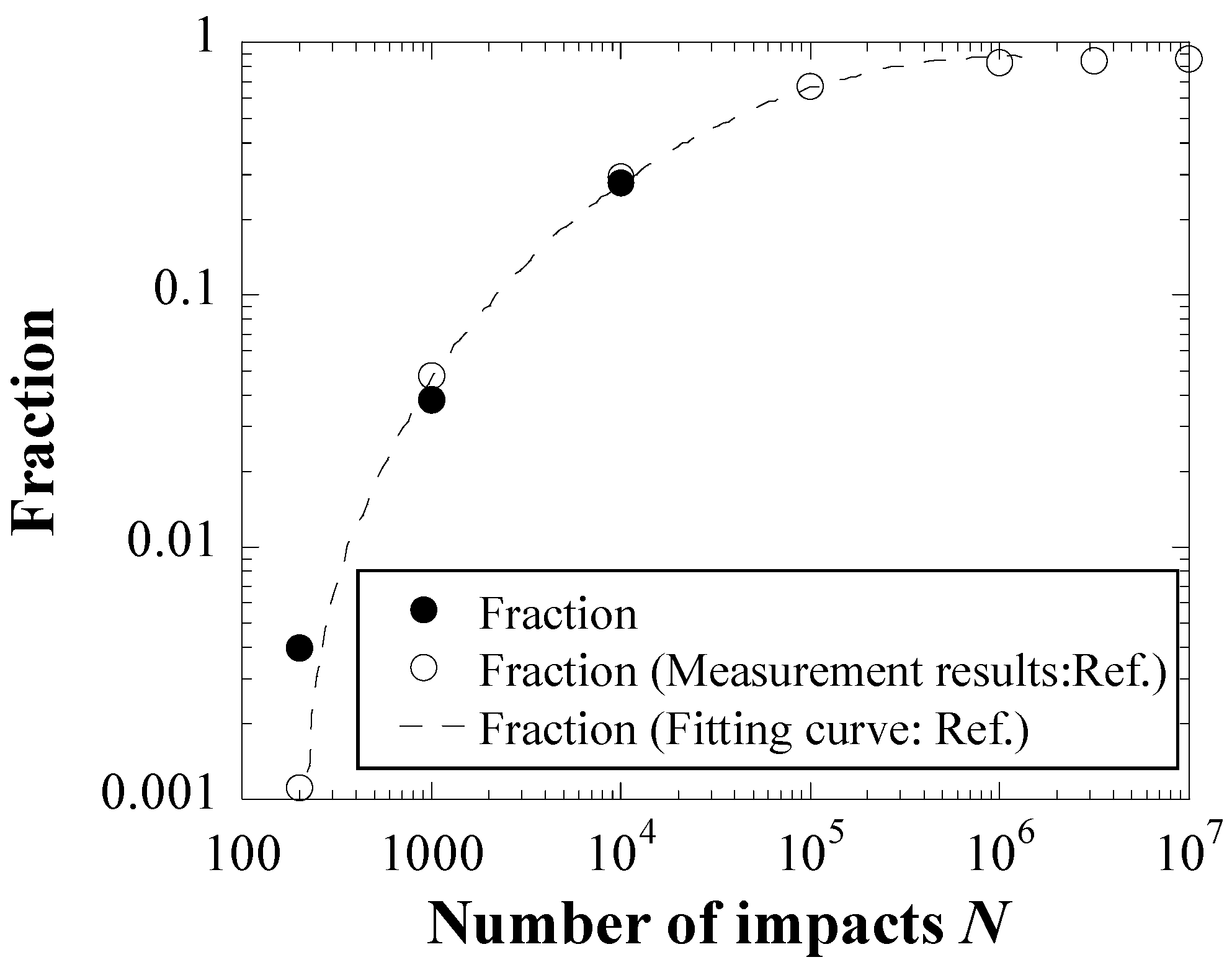
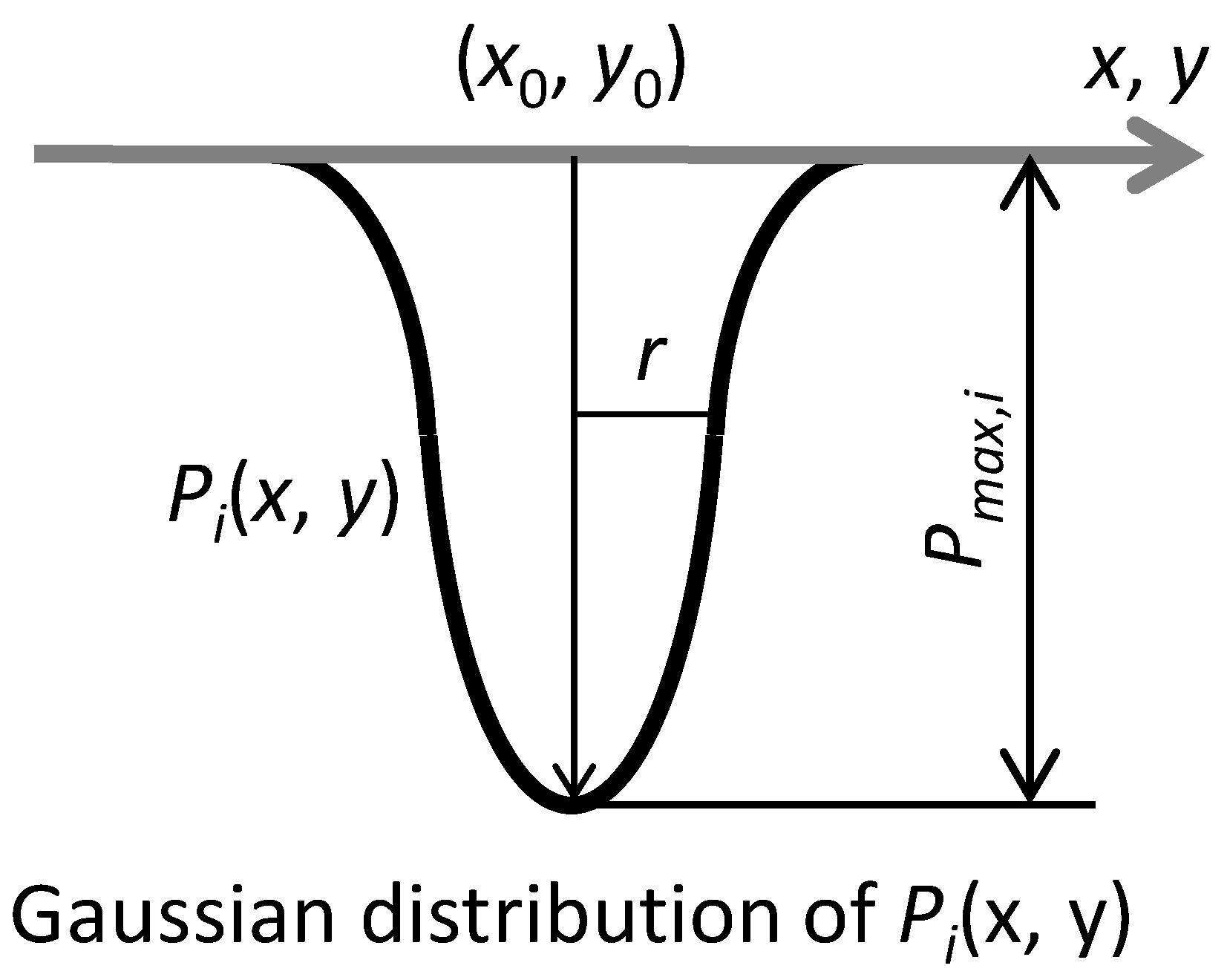
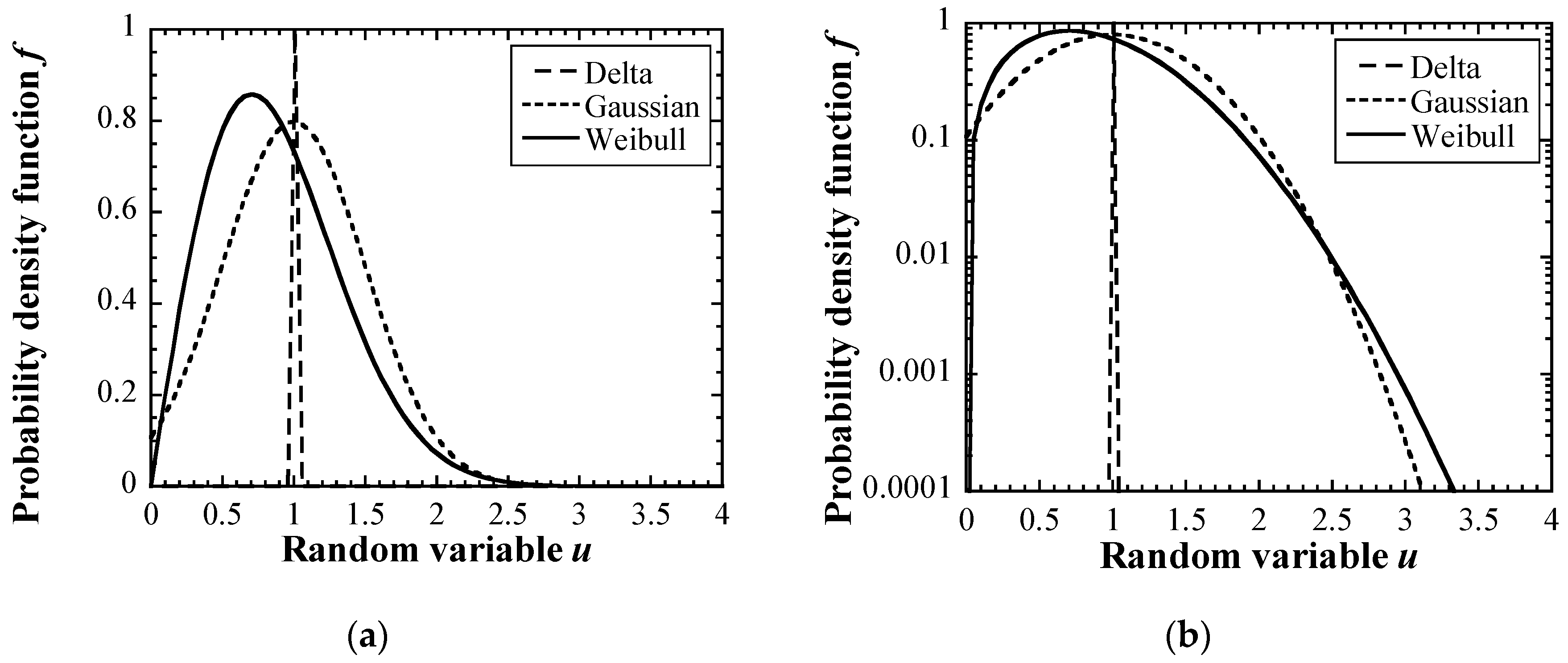
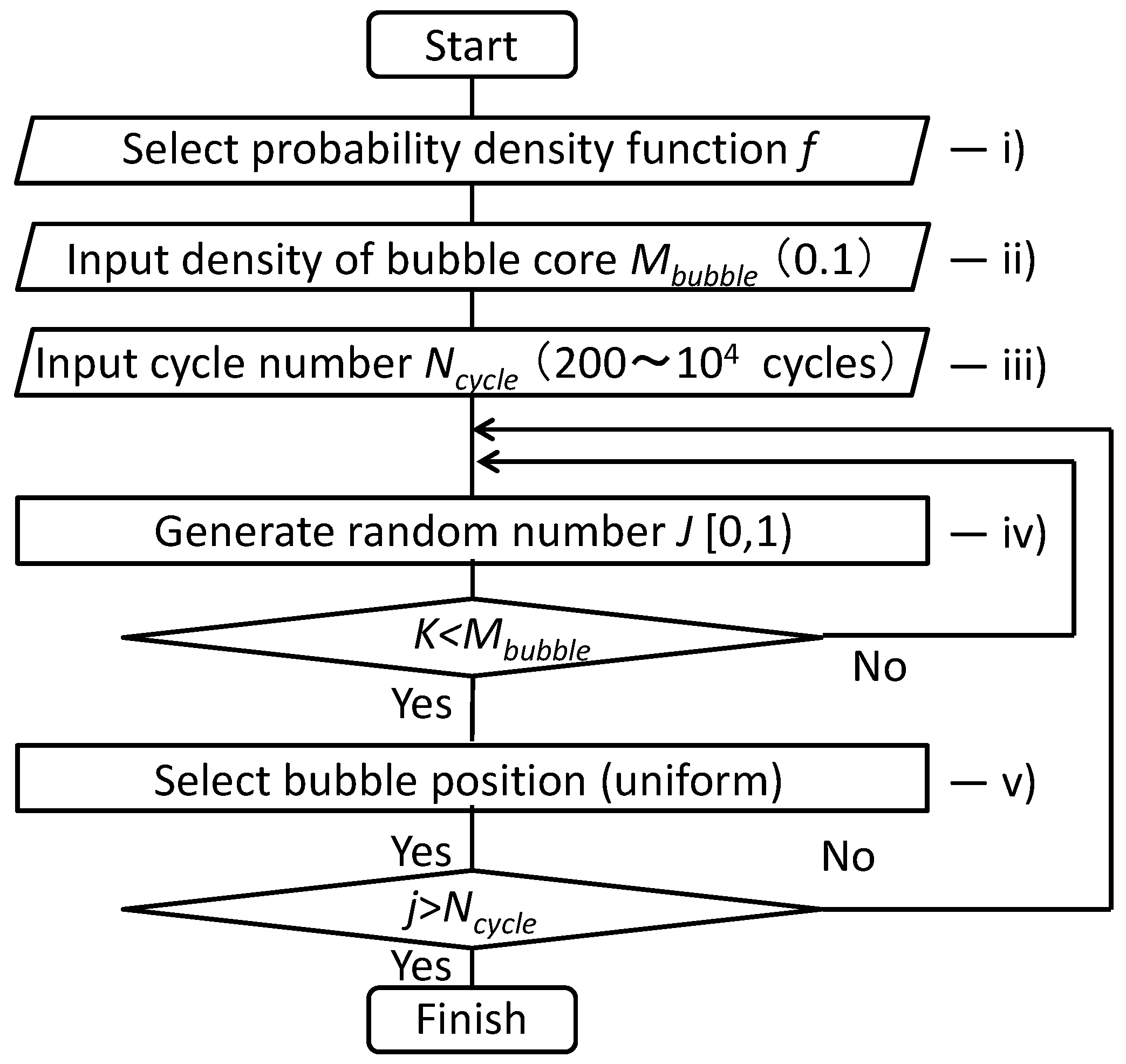

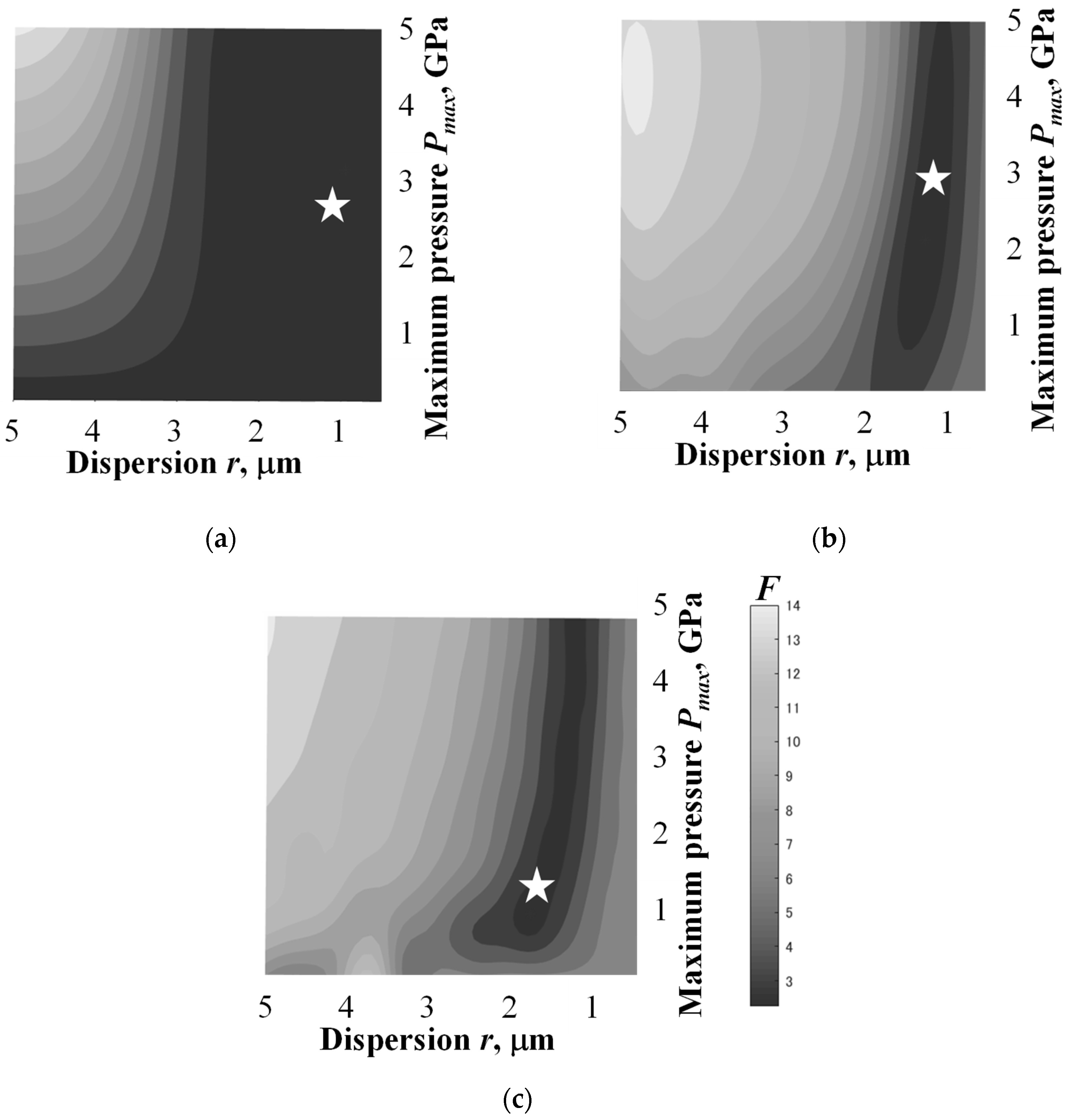
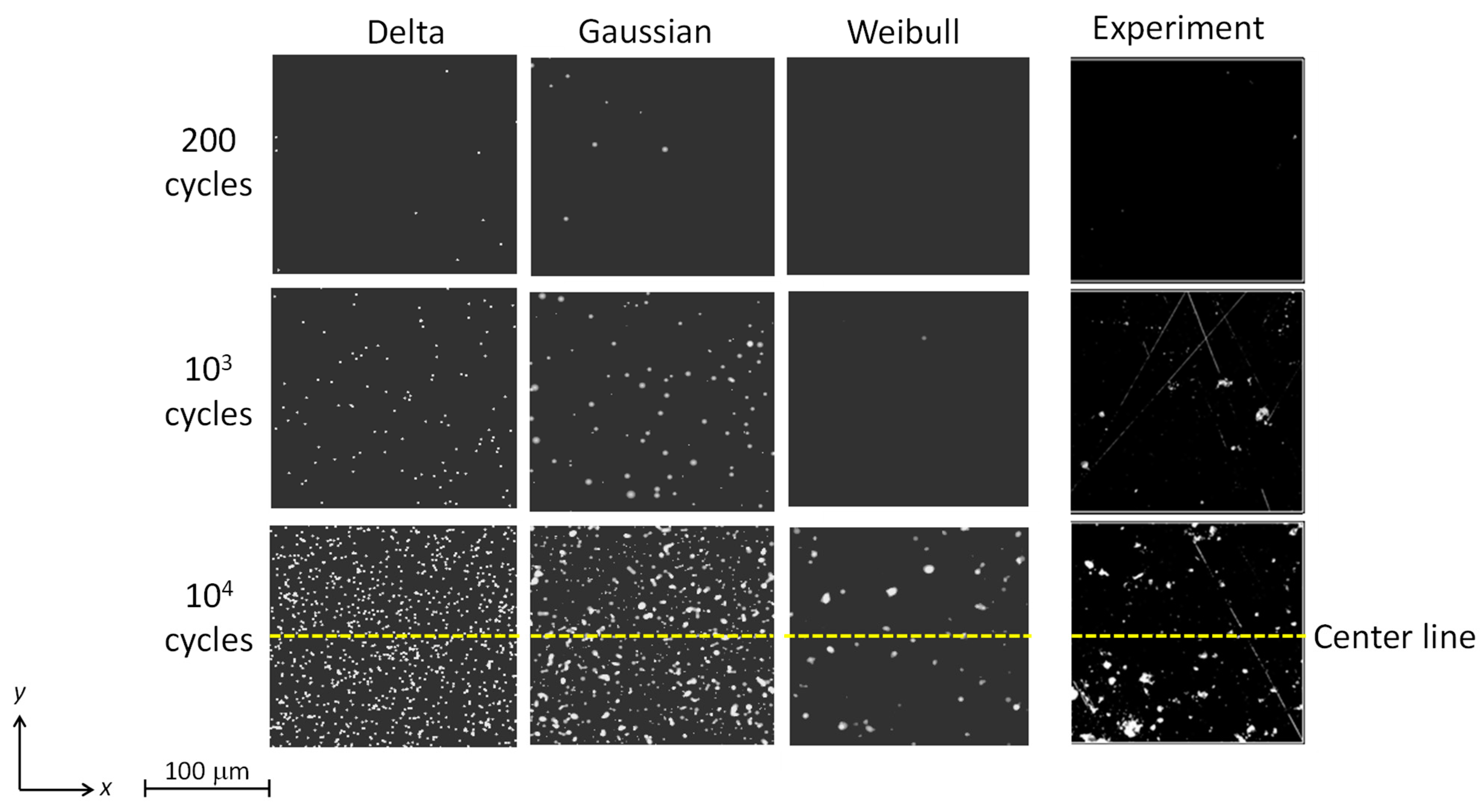
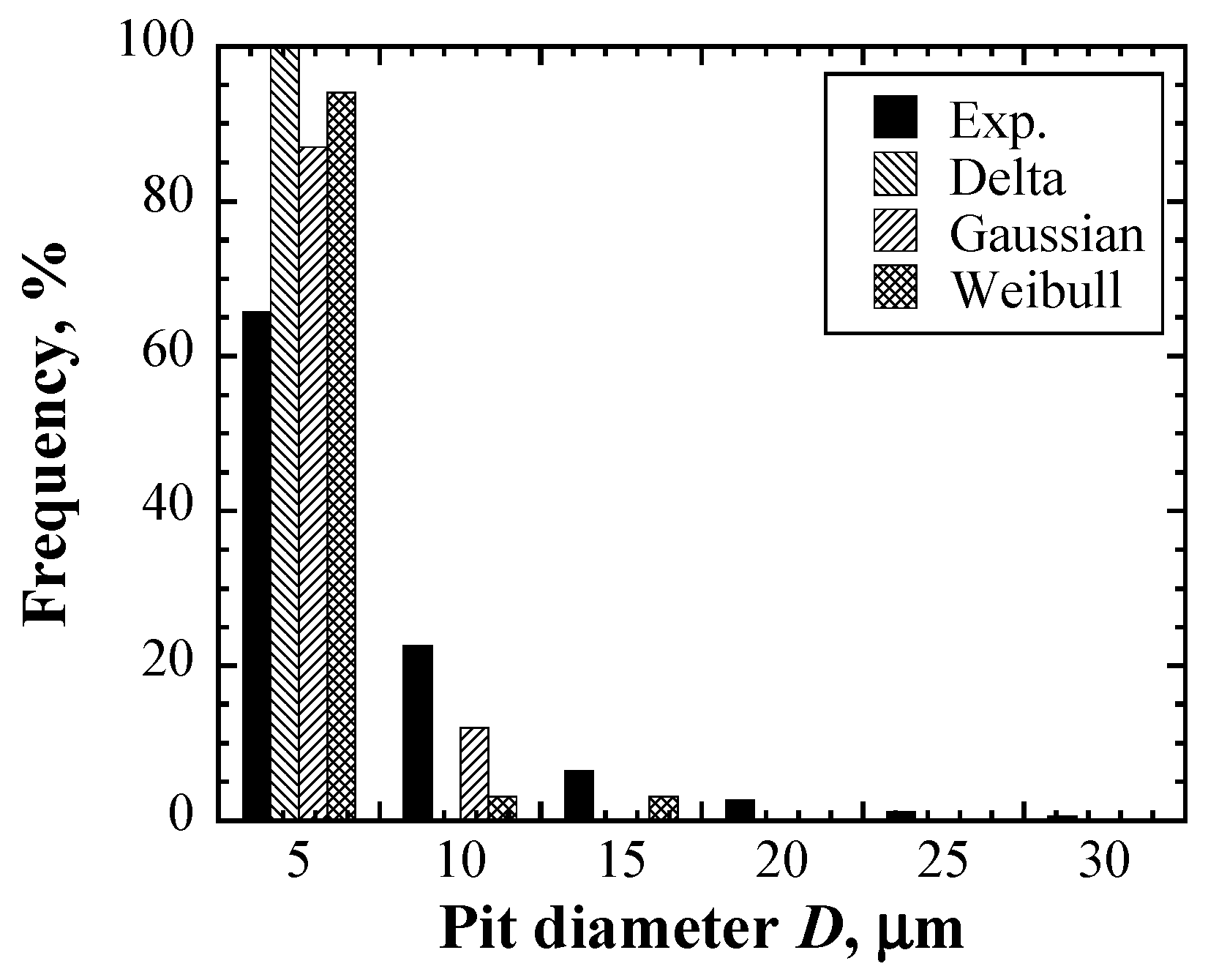
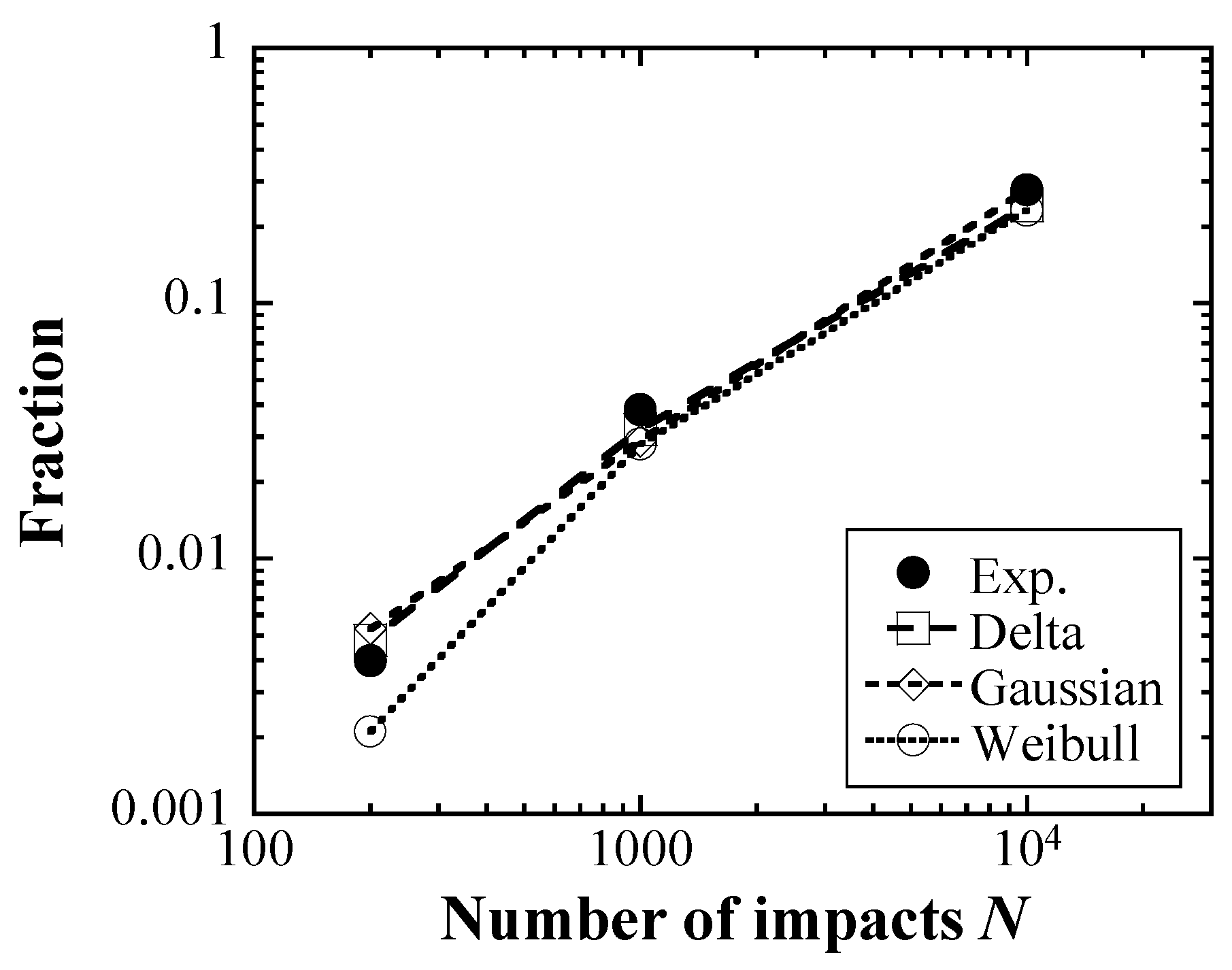
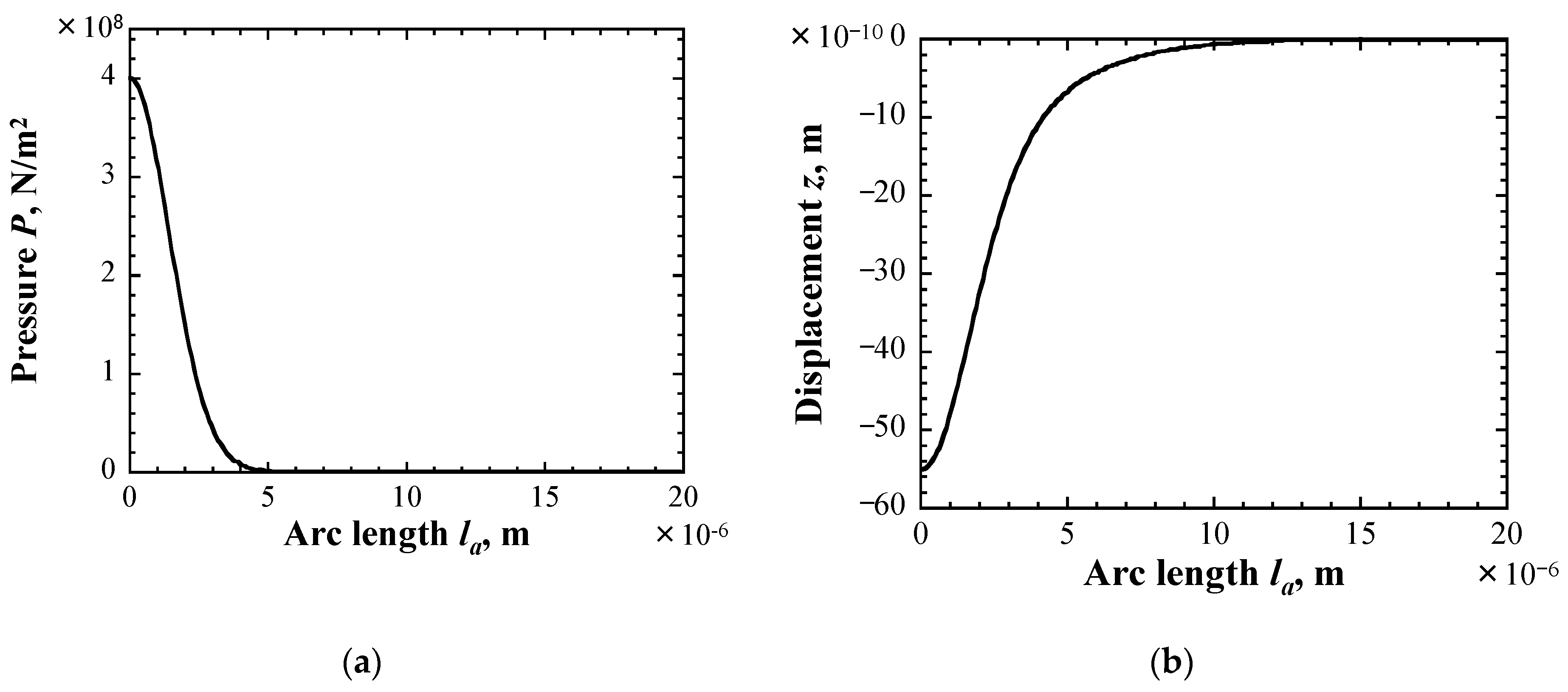

Disclaimer/Publisher’s Note: The statements, opinions and data contained in all publications are solely those of the individual author(s) and contributor(s) and not of MDPI and/or the editor(s). MDPI and/or the editor(s) disclaim responsibility for any injury to people or property resulting from any ideas, methods, instructions or products referred to in the content. |
© 2023 by the authors. Licensee MDPI, Basel, Switzerland. This article is an open access article distributed under the terms and conditions of the Creative Commons Attribution (CC BY) license (https://creativecommons.org/licenses/by/4.0/).
Share and Cite
Wakui, T.; Takagishi, Y.; Futakawa, M. Cavitation Damage Prediction in Mercury Target for Pulsed Spallation Neutron Source Using Monte Carlo Simulation. Materials 2023, 16, 5830. https://doi.org/10.3390/ma16175830
Wakui T, Takagishi Y, Futakawa M. Cavitation Damage Prediction in Mercury Target for Pulsed Spallation Neutron Source Using Monte Carlo Simulation. Materials. 2023; 16(17):5830. https://doi.org/10.3390/ma16175830
Chicago/Turabian StyleWakui, Takashi, Yoichi Takagishi, and Masatoshi Futakawa. 2023. "Cavitation Damage Prediction in Mercury Target for Pulsed Spallation Neutron Source Using Monte Carlo Simulation" Materials 16, no. 17: 5830. https://doi.org/10.3390/ma16175830
APA StyleWakui, T., Takagishi, Y., & Futakawa, M. (2023). Cavitation Damage Prediction in Mercury Target for Pulsed Spallation Neutron Source Using Monte Carlo Simulation. Materials, 16(17), 5830. https://doi.org/10.3390/ma16175830




